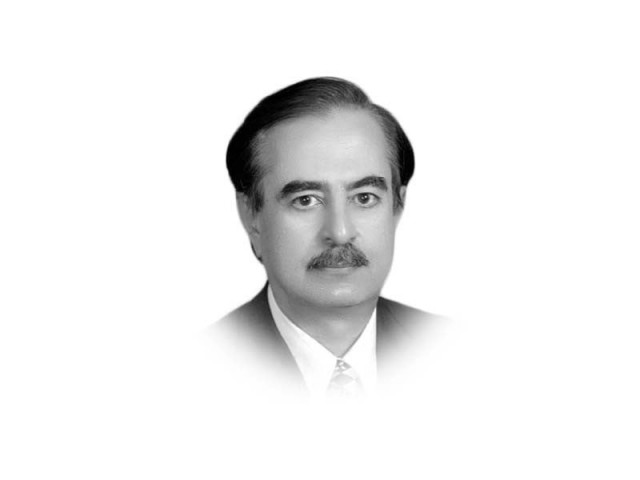Is IMF dispensable?
Pakistan is currently passing an interregnum, politically and economically

The present predicament may be summarised in the following way. The government is impoverished; one witnesses a plutocratic, self-flagellating society in constant, hallucinatory denial. Is IMF discardable? Yes.
IMF is dispensable if we set our house in order… but here’s the rub…!
The problems are common knowledge. After provincial shares, the government income barely suffices to pay for interest on previous loans and defence; for all other expenses the state depends upon borrowings. On the other hand “the richest 20% of the population own 49.6% of national income with the poorest 20% owning just 7%. The richest 1% held 9% of the country’s income of $314.4 billion in 2018-19 ($348 billion in 2023) and the poorest 1% held just 0. 15%. (UNDP, 2018). Only 1.9 million in a population of 243 million pay income tax; 40% or nearly 100 million live below the World Bank poverty line of $2.15 (Rs598) per day.
The economy shows persistent antipodals. Despite backbreaking CPI inflation of 23.1%, with 60% food inflation, there is hardly any shortage of luxuries. Shopping malls are chockablock with items that most of the underprivileged have never heard of: imported cheese, carbonated mineral water, chocolates, coffees and pet foods.
Industries suffer from power shortages, yet markets remain open up to closing hours of midnight despite the debt in the power sector (electricity and gas) soaring each year, standing presently at a phenomenal size of Rs5.7 trillion, or nearly 40% of the size of the total budget, 2024.
Statistics are telling. Electricity line and distribution losses, concealing huge pilferages, are 21% compared to 13% in India and 12% in Bangladesh.
One percent of large landowners own 23% of farmlands making a net income of Rs2,500 billion whereas agriculture income tax from the four provinces is only Rs2 billion or 0. 08%.
Capital gains tax on property is zero despite phenomenal appreciation of investments in property: an investment in a plot of Rs10 million, in 6 to 8 years’ time, revaluates to Rs50- 70 million.
With current GDP down to 0.5%, unemployment rate is close to 12.5%, meaning there are 10 million unemployed workers. About 21 million of youth are idle with 40% of school going age children out of school.
The government pays approximately Rs1.2 to 1.5 trillion annually, twice the size of the development budget, to meet losses of state enterprises like PIA, Railways, Steel Mill, Discos, NHA, Pakistan Broadcasting, etc.
Ambivalence exists vis a vis IMF whose neo liberal nostrums of free trade and capital flows, impinge upon the common man to the advantage of the elite and the privileged.
How is the government poor and society apparently well off? Two explanations exist. Firstly, consumerism in society aggravated by the fact that most of the growth in the economy is derived from unproductive investments and rentierism; and secondly, the prevalence of extreme income and wealth inequality.
The 0.2 to 0.8% elite derive approximately Rs2,700 billion in terms of tax exemptions, subsidies, etc whereas the BISP pro-poor welfare scheme is a mere Rs460 billion.
The high marginal propensity to consume, not restricted to the poor alone, has historic roots; withdrawal of royal patronage in pre- and post-British India led to constant precarity to status, wealth and fear of penurisation. Such a precarious hazard to lifestyles led to excessive propensity to consume and a low savings rate. Our gross national savings rate as percentage of GDP is only 10 to 10.5%. The saving rate in Bangladesh is 30.4% whereas in India it touches 31%.
Consumerism also reflects in industry: we produce consumer goods rather than high value added, exportable items like electrical and mechanical goods. New investments in productive industry are more or less non-existent since investors who possess surpluses, due to excessive government regulations and bureaucratic fleecing, feel safer in unproductive rentier investments in stocks, property, speculative purchases in foreign exchange or under-invoicing in imports.
On the external front a chronic deficit persists. Exports fetch only a third of foreign exchange required for essential imports. The major portion of imports consists of consumer items. Even intermediary goods, such as chemicals and raw materials, are mostly used for production of consumer goods. According to a study nearly 50-55% of all imports relate, directly or indirectly, to consumption oriented businesses and industry.
The IMF, adhering to the Bretton Woods agenda and the Washington Consensus, in pursuit of free market capitalism, insists upon free trade and free capital movement requiring deregulation of exchange rates. Yet most of the newly developed economies – China, India, Malaysia and Singapore – have adopted varying degrees of exchange control policies to protect their nascent economies and their people from incompatible competition and inflation due to the impact of fluctuations in the economies of the rich countries.
Why is the national savings rate so low and how does it relate to extreme inequality of income and wealth in society?
Agriculture remains a holy cow untouched by the type of land reforms that India witnessed after 1947 bringing land holding ceilings to 10-44 acres per family, varying from state to state. In case of Pakistan, despite three land reforms (in 1989 Land Reforms were declared unIslamic by a Shariat Bench of the Supreme Court against which an appeal in the Supreme Court awaits hearing despite the lapse of 35 years), there are rich feudals possessing 1000-5000 acres with many more owning 50-100 acres, paying an infinitesimal fraction of a fair income tax.
On conservative basis it has been estimated that the agriculture sector is not paying income and wealth tax worth between Rs1.2 to 1.5 trillion per annum equivalent to 16% of the total revenue in 2023-24.
Property and retail are the two other mollycoddled sectors that will need to be firmly addressed for taxation and productive growth.
Pakistan is currently passing an interregnum, politically and economically. The next few years will require belt tightening with low growth, lowering inflation, curtailing the current account deficit and stabilising the rupee.
After 3 to 4 years of a hard slog can we hope to get out of the repeated IMF cycle? It will depend upon how seriously we buckle up to putting our own house in order.
Published in The Express Tribune, April 1st, 2024.
Like Opinion & Editorial on Facebook, follow @ETOpEd on Twitter to receive all updates on all our daily pieces.













COMMENTS
Comments are moderated and generally will be posted if they are on-topic and not abusive.
For more information, please see our Comments FAQ